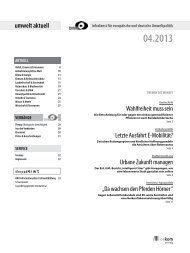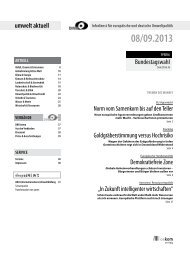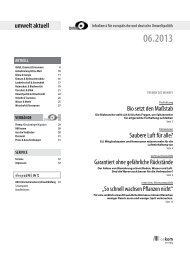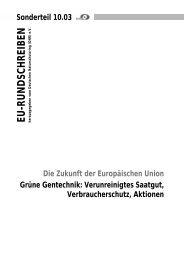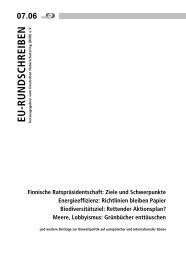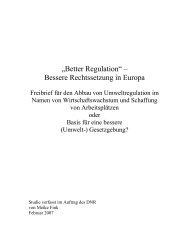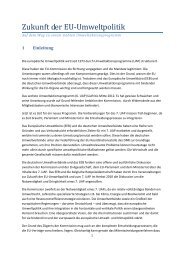Nachhaltiges Europa Abschlusspublikation - Global Marshall Plan
Nachhaltiges Europa Abschlusspublikation - Global Marshall Plan
Nachhaltiges Europa Abschlusspublikation - Global Marshall Plan
Erfolgreiche ePaper selbst erstellen
Machen Sie aus Ihren PDF Publikationen ein blätterbares Flipbook mit unserer einzigartigen Google optimierten e-Paper Software.
No stimulation for public understanding, no lead-<br />
ership.<br />
The EU-SDS has an additive rather than integrative<br />
character. The strategy is scattered over sev-<br />
eral documents and lacks an accessible and understandable<br />
message, which considerably weakens<br />
its impact on everyday decision-making. This for-<br />
mat does not stimulate public participation. Its<br />
messages have received extremely limited public<br />
attention, and even among small expert circles its<br />
influence has not been great. Accordingly, the EU-<br />
SDS does not provide the necessary leadership<br />
and its impact on public debate is limited. So far,<br />
the EU-SDS has not strengthened civil society en-<br />
gagement.<br />
Missing link to national SD Councils and Strategies<br />
and to civil society.<br />
The EU-SDS does not contain an adequate mechanism<br />
to involve civil society. National Councils for<br />
Sustainable Development could provisde one useful<br />
channel for expanding this engagement. There<br />
are now in Europe several national Councils for<br />
Sustainable Development, which have often developed<br />
from rather scientific, environment-oriented<br />
institutions into organisations engaging a broad<br />
range of stakeholders, reflecting civil society. On<br />
the national level, some national Councils for Sus-<br />
tainable Development have already recommended<br />
establishing linkages between the national SD<br />
Strategy in their respective country and the EU.<br />
There are examples for issue specific strategies –<br />
such as those relating to waste for example – that<br />
are driven by the need to meet the requirements<br />
of EU Directives. For other domestic goals and tar-<br />
gets, conditional targets (a national target is valid<br />
only if EU decides to set up a European target, see<br />
esp. the issue of climate change) are introduced.<br />
However, these examples are somewhat scattered.<br />
The lack of a specific strategy for linking EU<br />
SD policy to national policies is a serious weak-<br />
ness. For example the liberalisation of the electricity<br />
and gas markets will require accompanying<br />
measures to ensure sustainability on both national<br />
and EU level.<br />
Lack of interaction between national and European<br />
level.<br />
Currently, national SD Strategies and the EU-SDS<br />
are developing in isolation from each other. There<br />
is no formal or informal co-ordination between EU<br />
organs and national institutions. Instead, the ex-<br />
change of ideas between the European and national<br />
strategies is primarily based on informal and<br />
somewhat coincidental discussions between in-<br />
volved individuals, resulting in limited interaction<br />
between the EU-SDS and national SD Strategies.<br />
<strong>Nachhaltiges</strong> <strong>Europa</strong><br />
Accordingly, their environmental targets and indi-<br />
cators differ considerably. Only occasionally have<br />
these targets apparentlyinfluenced each other.<br />
Some national SD Strategies envisage an ambi-<br />
tious set of specific targets and timeframes,3<br />
whereas the EU-SDS does not contain these or<br />
similar targets and timeframes. There is a current<br />
lack of interaction between the European and the<br />
national level, the wording of national SD Strategies<br />
is often vague and omits specific EU-related<br />
commitments and timeframes.<br />
A poor long-term and political perspective.<br />
The strategy does thus not present a consistent<br />
approach in line with a long-term and politically<br />
binding strategy to cope with the unsustainable<br />
trends in economic, social and ecological challenges.<br />
Although the EU-SDS takes account of the<br />
need to adopt specific measures, it occasionally<br />
fails to set measures specific in scope and timeframe.<br />
The EU-SDS lacks clear targets to replace<br />
old technology, to increase the share of environ-<br />
mentally friendly cars by 2010 or to reduce CO2<br />
emissions in the order of 60 % by 2050, as proposed<br />
by Prime Ministers Blair and Persson in their<br />
letter to the Greek Presidency of 25 February<br />
2003.<br />
Proposed cut in the number of indicators is side-<br />
lining the core idea of sustainability.<br />
The list of more than 40 European indicators (with<br />
seven covering the environment) reflects the scat-<br />
tered character of the EU-SDS as these indicators<br />
do not necessarily correspond with the areas covered<br />
by the SDS and by Member States SD<br />
Strategies. Instead of clarifying and streamlining<br />
these indicators the European Commission recently<br />
proposed to cut the number of environment<br />
related indicators from seven to one. The cut is<br />
part of an overall reduction of the number of indicators<br />
used to measure the Lisbon process. The<br />
cut is sidelining environmental and SD indicators.<br />
As a late addition to the Lisbon process the Gothenburg<br />
European Council 2001 introduced a list of<br />
seven environmental indicators. Now, only the indicator<br />
for greenhouse gas emissions remains. The<br />
short list categorises two other indicators (energy<br />
intensity and volume of transport) as indicators of<br />
‘environmental’ aspects of sustainable develop-<br />
ment’, but it is doubtful that the implementation of<br />
these indicators will set the appropriate context for<br />
an adequate environmental assessment.<br />
3 E.g. energy and resource efficiency shall have doubled by 2020 (compared to 1990 respectively 1994), transport<br />
shall be reduced by 5 % (goods) and 20 % (persons) by 2020 (compared to 1999), exposure of the population<br />
to significant air pollutants shall be reduced by 70 % in 2010 (compared to 1990).<br />
19



